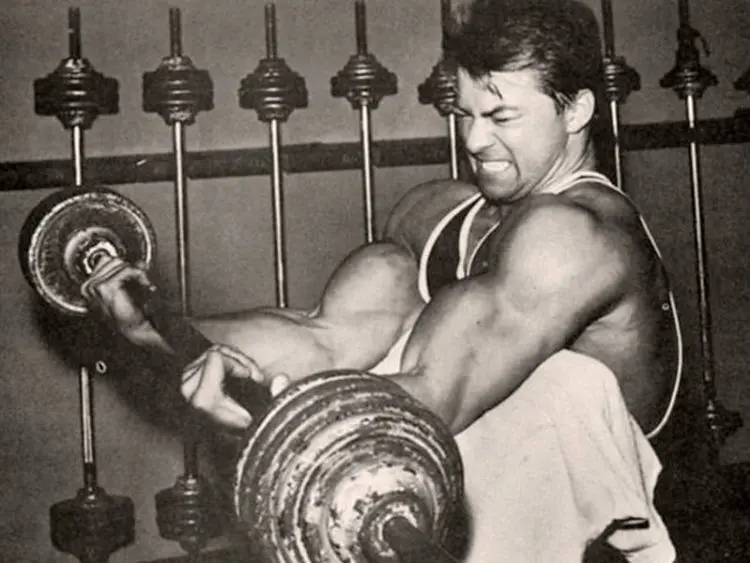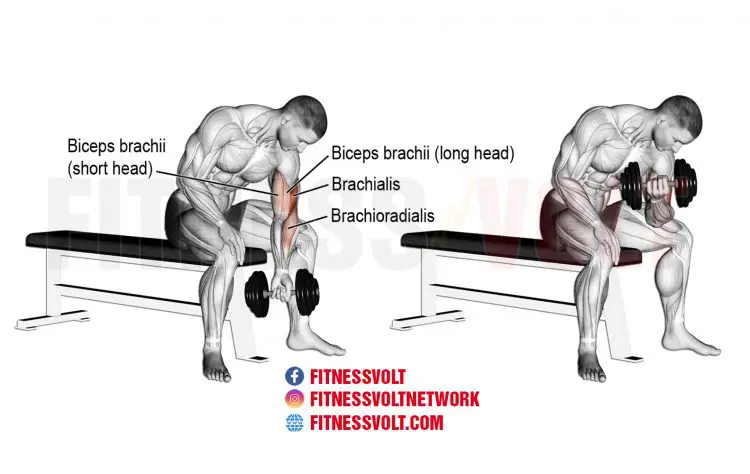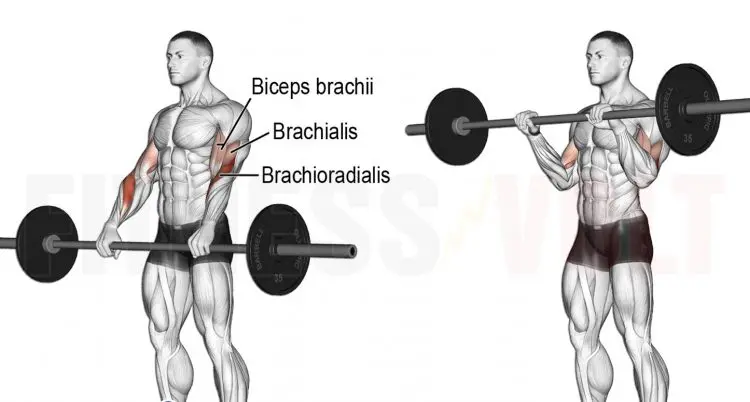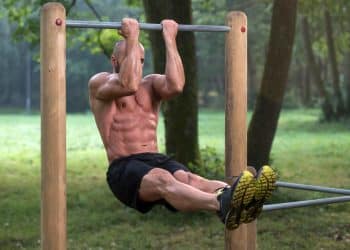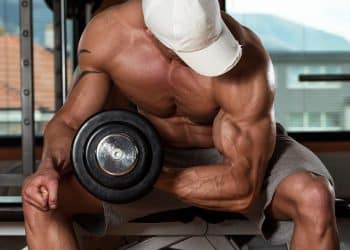The biceps brachii, or biceps for short, is arguably the most famous muscle in the human body. Even non-exercisers can point to where their biceps are!
The biceps brachii has two distinct heads: the long head and the short head. Both originate on the scapulae or shoulder blade and come together and insert into the radius bone of the forearm.
However, the short head is attached to the front part of the scapula, while the long head attaches more toward the rear. The short head is located on the inner arm and gives your biceps their width. In contrast, the long head is responsible for your biceps peak.
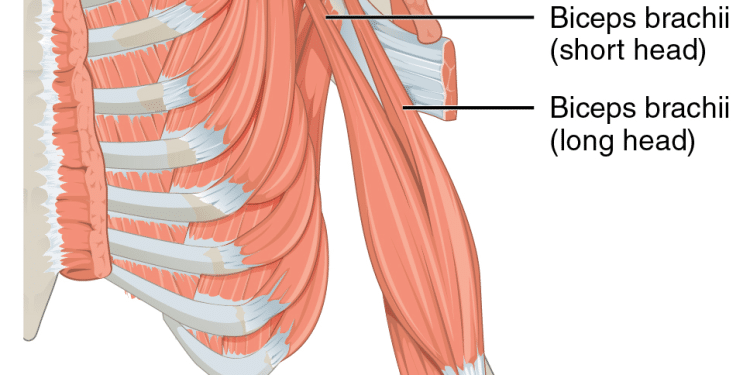
As a personal trainer with over 35 years of experience, many exercisers routinely come to me seeking ways to build thicker guns. In this article, I share the 16 best short bicep head exercises for building sleeving-ripping pythons.
Recent Updates: On July 15, 2024, Fitness Volt’s Content Strategist Tom Miller (CSCS) and Senior Editor Vidur Saini (American Council on Exercise-CPT) updated the article and added actionable expert tips throughout the piece to improve the reader experience. Level Up Your Fitness: Join our 💪 strong community in Fitness Volt Newsletter. Get daily inspiration, expert-backed workouts, nutrition tips, the latest in strength sports, and the support you need to reach your goals. Subscribe for free!
Use these exercises to build biceps thickness.
16 Best Short Head Biceps Exercises
Here are the short biceps head exercises that should be a part of your training regimen:
- Wide-Grip Bicep Curl
- Preacher Curls
- Spider Curl
- Concentration Curl
- Single-Dumbbell Preacher Curl
- Cable Hercules Curl
- Standing Inner Bicep Curl
- Supine Cable Curl
- Wide-Grip Chin Up
- Wide Inverted Row Underhand Grip
- Suspension Bicep Curl
- Lat Pulldown Overhead Curl
- Seated Cable Curl
- Seated Barbell Curl
- Zottman Curl
- Reverse Curls
1. Wide-Grip Bicep Curl
| Sets & Reps | Equipment Needed | Target Muscles |
| 3-4 x 8-12 | Barbell | Biceps brachii (short head emphasis) |
Barbell curls are a classic mass exercise. Using a barbell, you can go heavy and overload your biceps, making them great for building size and strength. They’re typically done using a hip-to-shoulder-width grip, which maximizes biomechanical efficiency so you can lift the heaviest possible weights.
However, if you move your hands out beyond shoulder width, you can use this exercise to emphasize your inner biceps. How wide? That’s up for debate, but your hands should definitely be wider than shoulder-width apart.
Move them out an inch or two to see how you respond to this exercise. Experiment with your grip width to find your short head sweet spot. You can also do wide-grip barbell curls using an EZ bar, which may be easier on your wrists.
Saini advises engaging your lats slightly by pulling your shoulder blades down and back. This will enhance biceps activation and protect your shoulders.
How to do it:
- Grab the barbell with a supinated wider than shoulder grip. Stand up straight, brace your abs and pull your shoulders down and back.
- Without using your legs or back, flex at your elbows and curl the weight up to your shoulder level.
- Lower the bar back down and repeat.
Pro Tip: Do not use momentum to curl the barbell. Keep your form strict and go as heavy as you can.
Benefits:
- This exercise is one of the best mass builders for the short biceps head.
- Swapping between normal to wide grip will enable you to train the biceps from different angles.
- You can use advanced training principles like forced reps more effectively while using a barbell.
| Difficulty | Progression | Regression |
| Beginner | Cable variation | Seated barbell curls |
2. Preacher Curls
| Sets & Reps | Equipment Needed | Target Muscles |
| 3-4 x 8-12 | Preacher curl machine/bench, dumbbells, or EZ-curl bar | Biceps brachii (short head emphasis), brachialis |
Golden-era bodybuilder Larry Scott was famous for his massive biceps. Scott’s unique arms helped him win two Mr. Universe titles and two Mr. Olympias. Scott’s biceps were remarkably thick, something that he attributed to preacher curls. The former Mr. Olympia champ was such a fan of preacher curls that this exercise became known as Scott curls.
“Preacher curls eliminate momentum, forcing strict form and maximizing biceps engagement, promoting overall growth,” says Saini.
There are several preacher curl variations you can use to target your inner biceps:
- Dumbbell preacher curls
- Barbell preacher curls
- EZ bar preacher curls
- Cable preacher curls
- Reverse dumbbell preacher curls
- Dumbbell hammer preacher curls
With all preacher curl exercises, your upper arms should stay pressed into the angled pad. Keep your elbows stationary to ensure your biceps do all of the work. Start each rep with your arms straight but not locked. Overextending your elbow could cause joint pain or biceps injury.
How to do it:
- Lean towards the angled pad of the preacher curl bench.
- Rest your armpits on the upper edge of the pad. Ensure the back of your arms is placed flat on the pad.
- Extend your arms to grab the loaded bar with a supinated grip.
- Curl the weight up until your forearms are vertical to the floor.
- Make sure your elbows are pointing forward and your arms are parallel to each other.
- Slowly bring down the barbell until your arms are fully extended.
- Hold for a second before you curl the weight up again.
- Perform for the recommended number of reps.
Pro Tip: Lower the weight under control and pause for a second before curling the weight for another rep.
Benefits:
- Targets short head muscles to develop well-defined biceps.
- Preacher curl helps avoid cheat reps.
| Difficulty | Progression | Regression |
| Intermediate | Slow down the eccentric (lowering) phase, try single-arm variations | Use lighter weight, reduce range of motion |
Also read best old-school Bicep Workouts.
3. Spider Curl
| Sets & Reps | Equipment Needed | Target Muscles |
| 3-4 x 8-12 | Incline bench, dumbbells, or EZ-curl bar | Biceps brachii (short head emphasis) |
While this exercise won’t turn you into a superhero like the Amazing Spider-Man, it is an incredibly effective exercise for targeting your inner biceps. Spider curls, also known as prone incline curls, are a cheat-free exercise because your upper body is supported by a bench. It’s very hard to use momentum to lift the weight in this position.
Saini explains that the incline position of the spider curl further isolates the short bicep head and increases the stretch at the bottom of the movement.
How to do it:
- Set an adjustable bench to about 45 degrees, and place your chest against the inclined pad.
- You can use dumbbells, a barbell, or an EZ bar for this exercise.
- Curl the weight up to your shoulder level.
- Lower it with a slow and controlled motion.
- Perform for the recommended number of reps.
Pro Tip: Contract your guns at the top for two seconds. Go light because this is a very strict arm exercise. Use a wide grip to really hammer those inner biceps.
Benefits:
- It helps you isolate your biceps.
- Improves the overall bicep definition and structure.
- Unlike the preacher curl, this variation won’t stress the elbow joint.
| Difficulty | Progression | Regression |
| Intermediate | Cable variation | Decrease the incline of the bench |
Learn more about this exercise in our in-depth guide.
4. Concentration Curl
| Sets & Reps | Equipment Needed | Target Muscles |
| 3-4 x 8-12 | Dumbbell | Biceps brachii (short head emphasis), brachialis |
Dumbbell concentration curls are so-called because they allow you to really concentrate on the muscle you are training. They eliminate upper back and leg involvement, making them a very strict exercise. Concentration curls also increase muscle activation toward the top of each rep, making them an effective short-head exercise.
“Concentration curls are excellent for developing mind-muscle connection due to the isolation and focus on each arm individually,” highlights Saini.
This exercise works best when done with light to moderate weights and medium to high reps. This is not a heavy-weight strength training exercise. Instead, keep your rests short and chase the pump!
How to do it:
- Sit upright on a flat bench or stool.
- Choose a comfortable weight.
- Spread your legs so you can rest the elbow of your working arm on the inside of your thigh.
- Keep your wrist supinated.
- Curl the dumbbell as high as possible.
- Pause at the contraction point.
- Slowly bring the weight down.
- Perform for the recommended reps before switching sides.
Pro Tip: As you curl the weight up, rotate your wrist to bring your pinky finger up. This wrist supination will help you feel a stronger contraction.
Benefits:
- Concentration curl improves the biceps peak and thickness.
- It allows you to work on a single biceps at a time.
| Difficulty | Progression | Regression |
| Beginner | Standing concentration curls | Conventional curls |
Learn how to do dumbbell concentration curls in this guide.
5. Single-Dumbbell Preacher Curl
| Sets & Reps | Equipment Needed | Target Muscles |
| 3-4 x 8-12 | Preacher curl machine/bench, dumbbell | Biceps brachii (short head emphasis), brachialis |
It is a great exercise to focus on one arm at a time. Unilateral movements hold a special place in our hearts because they can help reduce muscle imbalances and allow us to train both sides equally.
“Lean slightly forward to increase the stretch on the biceps at the bottom of the movement, then drive your elbow back as you curl for a full contraction,” cues Saini.
How to do it:
- Lean towards the angled pad of the preacher curl bench.
- Rest your right armpit on the upper edge of the pad. Ensure the back of your arms is placed flat on the pad.
- Hold a single dumbbell with a supinated grip.
- Curl the weight up until your forearm is vertical to the floor.
- Make sure your elbow is pointing forward.
- Slowly bring down the dumbbell until your arm is fully extended.
- Perform for the recommended number of reps before switching sides.
Pro Tip: Focus on controlled eccentrics, and do not overextend your elbows.
Benefits:
- It will improve the overall biceps size and strength.
- This exercise will help you train both sides equally.
- Unilateral training enhances mind-muscle connection.
| Difficulty | Progression | Regression |
| Intermediate | Machine variation | Limit range of motion |
6. Cable Hercules Curl
| Sets & Reps | Equipment Needed | Target Muscles |
| 3-4 x 8-12 | Cable machine, D-handles | Biceps brachii (short head emphasis), brachialis |
This exercise is also called ‘high pulley curls’. Cable Hercules curls not only isolate the bicep’s short head but also improve your front double biceps pose.
You will require to stand in the middle of the cable crossover machine while holding D-handles in both hands. When done correctly, the Hercules curl allows you to isolate the short biceps head quite effectively.
Saini recommends this exercise as it provides continuous tension throughout the entire range of motion, leading to greater muscle activation.
How to do it:
- Stand in the middle of the cable crossover machine.
- Set both pulleys around your shoulder height.
- Grab the cables with both hands. Stand tall, don’t lean forward or backward.
- Make sure your arms are parallel to the floor and your palms are facing the ceiling.
- Slowly curl both hands towards your head until your hands are above your shoulders.
- Hold the contraction for two seconds before you let the pulley return to the starting position.
- Repeat for the recommended number of reps.
Pro Tip: Don’t just move the weight from point-a to point-b. Use light weights and focus on muscle contraction.
Benefits:
- A great bicep isolation exercise that will strengthen the short head.
- Improves your double biceps poses.
- Nasty biceps pumps.
| Difficulty | Progression | Regression |
| Advanced | Tempo reps | Cable curls |
7. Standing Inner Bicep Curl
| Sets & Reps | Equipment Needed | Target Muscles |
| 3-4 x 8-12 | Dumbbells | Biceps brachii (short head emphasis) |
Now let’s talk about a dumbbell bicep curl variation that will specifically target the short head.
Saini suggests rotating your pinky finger up towards the ceiling as you curl to emphasize the wrist’s supination and target the biceps’ short head.
How to do it:
- Grab a pair of a dumbbell with a supinated grip.
- Retract your scapula, pin your elbows to your sides, and externally rotate your shoulders.
- While keeping the upper arms stationary, exhale and curl the dumbbells.
- Hold the contraction for two seconds at the top before slowly bringing the weight down.
- Repeat for recommended reps.
Pro Tip: Maintain 1-2-4 tempo: One-second concentric, two-second hold at peak contraction, and four seconds eccentric.
Benefits:
- It helps target the short biceps head with just dumbbells. No bench is needed.
- Easy to perform and lets you train heavy.
| Difficulty | Progression | Regression |
| Beginner | Seated inner bicep curls | Use a resistance band |
8. Supine Cable Curl
| Sets & Reps | Equipment Needed | Target Muscles |
| 3-4 x 8-12 | Low pulley cable machine, straight or EZ-curl bar attachment | Biceps brachii (short head emphasis) |
Supine cable curls are a strict biceps exercise. Lying on the floor means you cannot use your back or legs to help lift the weight; it’s biceps power all the way!
This exercise is best done for medium to high reps using light to moderate weights. It’s not really suitable for heavy weights or low reps. Use a straight or EZ bar as preferred.
Saini highlights the importance of ensuring your elbows stay pinned to the floor throughout the movement to prevent any cheating or use of momentum.
How to do it:
- Attach a straight bar to a low pulley machine. Grab the handle with an underhand, shoulder-width grip.
- Lie down on the floor with the pulley between your feet. Pin your elbows to your sides.
- With your shoulders pulled down and back, abs braced, and your head resting on the floor, bend your arms and curl the handle up to your shoulder level.
- Extend your arms and repeat.
Pro Tip: Squeeze your guns with every rep for two seconds for an optimum biceps pump.
Benefits:
- It’s an excellent biceps exercise that improves strength and size.
- Lying down straight on the floor eliminates the possibility of using momentum to curl the bar.
| Difficulty | Progression | Regression |
| Intermediate | Cable preacher curl | Standing cable curl |
9. Wide-Grip Chin Up
| Sets & Reps | Equipment Needed | Target Muscles |
| 3-4 sets to failure (or add weight if possible) | Chin-up bar | Biceps brachii (short head emphasis), lats, upper back |
Don’t worry, you haven’t accidentally started reading an article on back training! While chin-ups are an excellent lat exercise, they can also target the inner biceps.
The main advantage of this exercise is that you can go really heavy without resorting to cheating. After all, can you curl your bodyweight?
The key to making chin-ups a good short head exercise is to make sure you pull your chin all the way up and over the bar; no half-repping! It’s the top of each rep that really hammers your inner biceps.
Saini recommends focusing on pulling your elbows down and back rather than just pulling yourself up. This will emphasize the biceps and reduce the involvement of the lats.
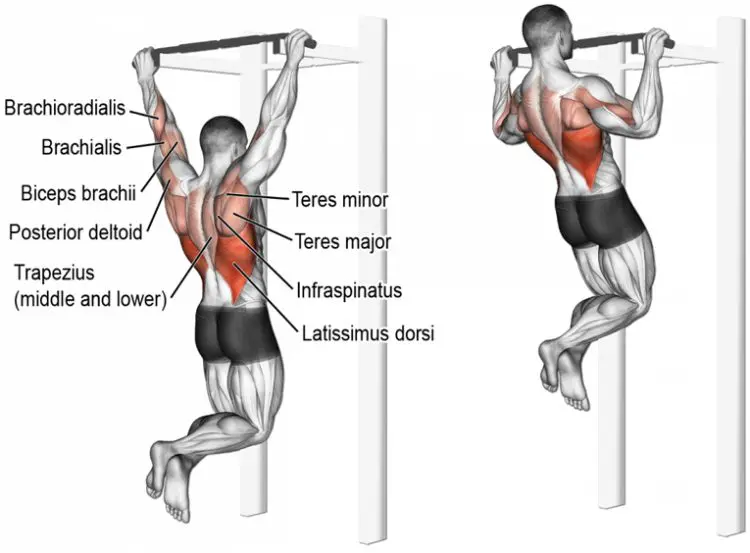
How to do it:
- Grab the pull-up bar with an underhand grip.
- Your hands should be a little wider than shoulder width.
- Retract your scapula and pull yourself towards the ceiling until your chin is over the bar.
- Hold the contraction for a second before lowering yourself to the starting position.
- Perform as many reps as possible.
Pro Tip: Those who can’t do a chin-up can perform assisted chin-ups using resistance bands or an assisted pull-up machine.
Benefits:
- Chin-ups are a compound movement that will help you develop a more muscular back.
- Wide grip chin-ups can help boost biceps strength and size.
- Chin-ups also improve grip strength.
| Difficulty | Progression | Regression |
| Advanced | Add weight with a belt or vest | Use an assisted chin-up machine or resistance band, do negative chin-ups (lowering phase only) |
Learn how to do chin-ups (and their close relative pull-ups) in our in-depth guide.
Level Up Your Fitness: Join our 💪 strong community in Fitness Volt Newsletter. Get daily inspiration, expert-backed workouts, nutrition tips, the latest in strength sports, and the support you need to reach your goals. Subscribe for free!
10. Wide Inverted Row Underhand Grip
| Sets & Reps | Equipment Needed | Target Muscles |
| 3-4 x 8-12 | Smith machine or suspension trainer | Biceps brachii (short head emphasis), lats, upper back |
Inverted rows may not be a popular movement, but that doesn’t make it any less effective exercise. This exercise has the potential to replicate the benefits of chin-ups. Additionally, they are an excellent exercise for those who find chin-ups challenging.
“Inverted rows with an underhand grip are a great bodyweight alternative to chin-ups, targeting the biceps and back muscles effectively,” adds Saini.
How to do it:
- Set the barbell at around waist level.
- Get underneath the barbell and grab it with a wide supinated grip.
- Extend your arms.
- Retract the scapula to create tension in the upper back. This will be the starting position for the exercise.
- Your body should be in a straight line at the starting position.
- Exhale and pull yourself towards the bar.
- Hold the contraction for two seconds before slowly returning to the starting position.
Pro Tip: Emphasize slow and controlled negative reps. You can switch between wide and narrow grips to train the biceps from different angles.
Benefits:
- Keeping the grip wide will help you focus more on the short biceps head.
- The inverted row is a compound exercise that targets the back and biceps. It will also improve core stability and muscle coordination.
- It’s a beginner-friendly workout that can help you gain upper body strength.
| Difficulty | Progression | Regression |
| Intermediate | Elevate feet on a box or bench, use a barbell instead of rings or straps | Lower your body closer to the ground for easier reps |
11. Suspension Bicep Curl
| Sets & Reps | Equipment Needed | Target Muscles |
| 3-4 sets to failure | Suspension trainer | Biceps brachii (short head emphasis) |
Suspension trainers have gained a lot of popularity in recent times. The suspension bicep curl is great for someone who relies on TRX or gymnastic rings for their workout.
Saini underscores that the suspension bicep curls offer a unique challenge due to the instability, forcing the biceps to work harder to stabilize and control the movement.
How to do it:
- Adjust the suspension straps so the handles are at your waist height.
- Hold the handles with a supinated grip and step back.
- Slowly lean back until your arms are fully extended, and your body is at a 45-60 degree angle with the floor.
- Keep your core tight and feet flat on the ground.
- Bend at your elbows to raise your body towards the handles.
- Slowly return to the starting position.
Pro Tip: You can increase or decrease the body angle according to your strength levels.
Benefits:
- Suspension trainers allow you to rotate your wrists for better muscle contraction.
- You can always increase or decrease the intensity by changing the length of the suspension straps.
| Difficulty | Progression | Regression |
| Intermediate | Lean further back, decrease foot base for more instability | Stand more upright, increase foot base for more stability |
12. Lat Pulldown Overhead Curl
| Sets & Reps | Equipment Needed | Target Muscles |
| 3-4 x 8-12 | Lat pulldown machine | Biceps brachii (short head emphasis), lats |
This exercise might look weird, but it’s a great bicep isolation exercise to target the short biceps head.
Although you can do this exercise with any high pully, the lat pull-down machine is more suitable as it allows you to anchor your lower body more efficiently.
Saini adds that the lat pulldown overhead curl is a hybrid exercise that combines a vertical pull with a curl, engaging both the lats and biceps for maximum upper-body stimulation.
How to do it:
- Grab the bar with a supinated grip and sit on the bench with your arms fully extended.
- Lean backward slightly.
- Keep your upper arms and elbows fixed in position.
- Slowly curl the bar and let it go behind your head for full contraction.
- Pause for two seconds before letting the bar back to starting position.
- Repeat for recommended reps.
Pro Tip: Do not let the weight fall back! Maintain total control during the eccentric movement. Don’t allow your elbows to move back and forth as you curl the weight.
Benefits:
- Improves bicep size and definition.
- The overhead arm position better isolates the short biceps head.
| Difficulty | Progression | Regression |
| Advanced | Increase weight, slow down the eccentric phase | Use lighter weight, reduce range of motion |
13. Seated Cable Curl
| Sets & Reps | Equipment Needed | Target Muscles |
| 3-4 x 8-12 | Low pulley cable machine, straight or EZ-curl bar attachment | Biceps brachii (short head emphasis) |
It might look like a preacher curl replica, but this variation allows you to lift heavier weights, and it’s more joint-friendly as it doesn’t overextend the elbow joints at the bottom.
“Adjust the seat height so that your elbows are aligned with the cable pulleys,” cues Saini. This will optimize the angle of pull and maximize biceps activation.
How to do it:
- Sit on the seated cable row machine and place your feet on the foot platform.
- Bend your knees slightly and keep your torso in an upright position.
- Grab the bar with a supinated grip.
- Place your elbows on your knees with your elbows pointing forward.
- Curl the bar towards your chin.
- Pause at the top.
- Slowly return to the starting position.
- Repeat for recommended reps.
Pro Tip: Avoid using momentum by swinging your torso back and forth.
Benefits:
- Placing your elbows on your knees results in better biceps isolation.
- Seated cable curls target your short biceps head and help build thicker guns.
| Difficulty | Progression | Regression |
| Beginner | Unilateral variation | Standard cable curl |
14. Seated Barbell Curl
| Sets & Reps | Equipment Needed | Target Muscles |
| 3-4 x 8-12 | Barbell | Biceps brachii (short head emphasis) |
This unusual curl variation increases short biceps head activation by preventing full arm extension. It can be done using dumbbells or an EZ bar but works best with a straight barbell.
Saini suggests keeping your shoulders pulled back and down throughout the movement to prevent any shoulder impingement or discomfort.
How to do it:
- Adjust your bench so that the backrest is close to vertical. Hold a barbell with a shoulder-width, underhand grip. Sit on the bench and rest the barbell on your thighs.
- Keeping your back against the backrest, bend your arms and curl the bar to your shoulder level.
- Lower the bar to the starting position and repeat.
- You can also do this exercise with a wider than shoulder-width grip to increase inner biceps activation.
Pro Tip: As the biceps fatigue, drop the weight by 20-25 percent to do ten more reps.
Benefits:
- The sticking point of a standard biceps curl is at the bottom of the movement. Seated barbell curl allows you to lift heavy by eliminating full arm extension.
- Improves bicep size and forearm strength.
| Difficulty | Progression | Regression |
| Beginner | Use an EZ-curl bar for wrist comfort | Use lighter weight, do standing barbell curls |
15. Zottman Curl
| Sets & Reps | Equipment Needed | Target Muscles |
| 3-4 x 8-12 | Dumbbells | Biceps brachii, brachialis, forearms |
This exercise is named after George Zottman, who was an American strongman famed for his massive arms. Zottman was born in 1867 and died in 1942, and was from Philadelphia, PA.
Zottman curls are an old-school biceps exercise. They work both the biceps brachii and the brachialis, with an emphasis on the short biceps head. It is a very time-efficient exercise and ideal for when you are short on time.
Zottman curls can be done while standing, but for better isolation and less potential for cheating, you can also do them while seated.
“Control the lowering phase of the movement, especially during the pronation of the wrist, to emphasize the stretch on the biceps and forearms,” cues Saini.
How to do it:
- Hold a pair of dumbbells with a neutral grip (palms facing each other) at your sides.
- Supinate your wrist as you curl the dumbbells while keeping your elbows pinned to your sides.
- Pause and contract your pythons at the top.
- Slowly return to the starting position while pronating your wrists.
- Repeat the movement for recommended reps.
Pro Tip: Don’t go heavy. Practice this exercise with moderate weight. Perform slow and controlled reps for best results.
Benefits:
- The Zottman curl can help you develop more strength and control over the biceps.
- It will also help you create stronger forearms as a lot of wrist rotation is involved in the movement.
- This exercise strengthens both long and short heads.
| Difficulty | Progression | Regression |
| Intermediate | Increase weight | Conventional dumbbell curls |
Learn more about this classic arm exercise with our in-depth guide.
16. Reverse Curls
| Sets & Reps | Equipment Needed | Target Muscles |
| 3-4 x 8-12 | Barbell or dumbbells | Brachialis, brachioradialis |
This is another exercise usually associated with the biceps brachialis that is also a useful short head exercise. Reverse curls are done with a pronated (palms down) grip instead of the more usual supinated or palms up grip. This is not a very biomechanically efficient position, so you won’t be able to lift as much weight as usual. However, this is still an effective inner biceps and forearm exercise.
Saini explains that reverse curls primarily target the brachialis, a muscle located under the biceps, which can help push the biceps up and create a more prominent peak.
Pro Tip: Keep your wrists straight throughout the movement to minimize stress on the wrist joints and maximize brachialis engagement.
| Difficulty | Progression | Regression |
| Intermediate | Increase weight, use an EZ-curl bar for wrist comfort | Use lighter weight, do hammer curls |
You can do reverse curls several ways:
Tips To Emphasize on The Short Head
Although you cannot isolate the short head, there are some techniques to make it work harder. Understanding the following concepts will help you better target the short biceps head:
1. Elbow Positioning
The short biceps head is better engaged when your elbows are pointing forward, for example, preacher curl and supine cable curl.
2. Grip Positioning
Suppose you are doing a barbell bicep curl; you can choose between a narrow, medium, and wide grip.
- Effects of close grip on bicep activation: Emphasize the long biceps head.
- Effects of medium grip: When you grab the barbell at shoulder width distance, it equally targets both heads.
- Effects of wide grip: When you grip the barbell wider than shoulder width, it emphasizes the short head.
3. Wrist Rotation
You can alter biceps stimulation by adjusting your wrist position.
Supinating the wrist so that your pinky finger is higher than the index finger will help you focus on the short biceps head. You can also try this without weight; flex your elbows to contract the biceps, turn your pinky fingers in, and rotate your wrist outward. You should feel better activation of the short head.
But wrist rotation is applicable when training with dumbbells, and we cannot rotate our wrists while holding a barbell, right? That’s why we hold the barbell with a wide grip to emphasize the short head. When you grab the barbell with a wide grip, your wrists supinate automatically and better activate the short head.
Short Head Biceps Workout
You can beef up your inner biceps by adding these exercises to your current arm workouts. But, if you are serious about increasing the size of your short head, give this workout a try.
Do it once a week, a few days after your usual arm workout. Yes, that’s right, we want you to train your biceps twice a week to shock them into new levels of strength and size!
| Exercise | Sets | Reps | Recovery | |
| 1 | Chin-ups | 4 | 6 | 120 seconds |
| 2 | Preacher curls | 3 | 8 | 90 seconds |
| 3 | Zottman curls | 2 | 10 | 60 seconds |
| 4 | Concentration curls | 2 | 12 | 45 seconds |
Related: 10 Best Long Head Biceps Exercises for Bigger Arms and A Higher Peak
Benefits of Training The Short Biceps Head
Paying special emphasis on the short biceps head has the following benefits:
- Improves biceps width.
- Consistent short biceps head training can improve your front-double biceps pose by giving your biceps a fuller look.
- Short biceps heads support biceps adduction, which brings stability and functional ability.
How To Push Your Biceps For Growth?
Doing the right exercises alone is not always enough to stimulate growth. If gaining muscle size and strength was so simple, every lifter would have twenty-inch biceps. Here are a few tips to take your biceps training to another level:
1. Forced Reps
Per the basic tenets of bodybuilding, your muscles adapt to an external stimulus by growing bigger and stronger.
A forced rep involves pushing yourself beyond the point of failure during a set with the assistance of a training partner. Plus, you could consider cheat reps done after hitting failure as forced reps.
The forced rep principle involves pushing through your physical limits to complete a few more reps. It makes your body adapt to higher volume, thus stimulating growth and improving muscle density.
Remember, the whole set should not comprise cheat reps. Complete a few reps with strict form until your muscles are smoked, then use assistance to force yourself to do a few more forced reps. While doing forced reps, you should emphasize the slower eccentric motion to maximize muscle hypertrophy.
2. Drop Sets
These are also known as descending sets. A drop set is another way to force yourself to achieve maximum muscle stimulus.
How to do drop sets?
Select a weight that you can lift for 10-12 reps with perfect form. Once you complete the initial reps, drop the weight by 20 percent and do another 8-10 reps; drop the weight once again and go for another 8-10 reps. Do not rest between sets.
Ideally, you should not do a drop set for every exercise and set. Use it as a workout finisher.
Learn more on how to build muscle faster with Drop Sets.
3. Bring Your Reps Down
Many people get comfortable with the 10-12 rep range. However, you should occasionally increase the weight and bring the reps down to let your muscles and tendons adapt to heavier weights.
Bringing the reps down has many benefits. Training heavy stimulates the muscle fibers to adapt to heavier loads and promotes the release of growth hormones.
Those who want to achieve power and hypertrophy all at once can plan their workout with a mix of heavy, moderate, and lightweight isolation and compound exercises.
For example: On the biceps training day, you can do a barbell curl with heavy weight and low reps, then preacher curls with moderate weight and wide-grip chin-ups to failure.
4. Don’t Neglect the Compound Lifts
Do not skip compound lifts if you want to increase your strength and lifting ability. Compound movements not only train big muscle groups but also strengthen the smaller stabilizer muscles that support other exercises.
For example: Chin-ups are a great compound exercise that strengthens your arms, back and core.
Short Head Bicep Training Tips
Here are a few tips to optimize your short biceps head training:
1. Short biceps head activation
Pre-workout muscle activation is the best way to ensure your muscle is prepared for strength training. You can follow these tips to activate your short-head muscle fibers.
- Wide-grip empty barbell bicep curls: Perform a high number of reps to get the blood flowing into the target muscle group.
- Bicep curls with resistance band: Resistance bands work great for muscle activation. The variable resistance allows you to squeeze the target muscle harder at the peak contraction point, improving your mind-muscle connection.
- Two sets of wide-grip chin-ups: A two-second pause at the top of the movement has been found to be a very effective way to activate the biceps (especially the short head).
2. Training volume
When training for hypertrophy and strength, one should never neglect the importance of training volume. Doing 12-14 working sets per week can be a sweet spot for most lifters. However, how you break those sets in your training routine should depend on your training protocol.
3. Rep ranges
Rep range may vary according to an individual’s fitness goal. In general, your training should be divided into heavy, moderate, and light-weight exercises.
Aim for 3-5 reps with heavy weights, 8-12 reps with moderate weights, and 15+ reps with light weights. The short head is not a very big muscle, and performing one-rep max (1RM) doesn’t make sense.
Wrapping Up
All biceps exercises involve the short head, so it may not be necessary to spend extra time working on this muscle. That’s especially true if you are a recreational (non-competitive) bodybuilder or are more interested in strength and performance than muscle size.
However, if your goal is to sculpt the most aesthetically pleasing physique possible, you can’t afford to have any weak links. Doing more inner biceps work could be the difference between good and GREAT arms.
Use these exercises to bulk up your inner biceps and give your arms more thickness.

